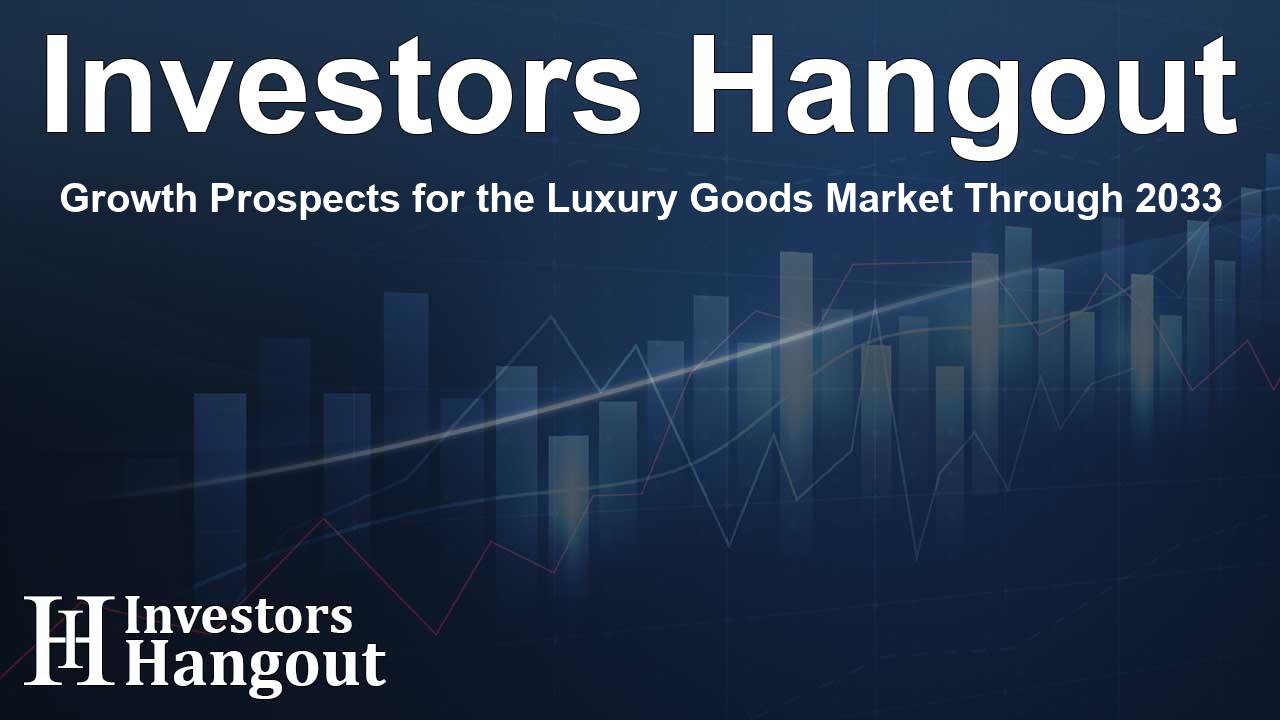Growth Prospects for the Luxury Goods Market Through 2033

The Expanding Luxury Goods Market: Future Projections
The luxury goods market has become a prominent sector within the global economy, showcasing a diverse range of high-end products such as fashionable apparel, exquisite accessories, premium cosmetics, and elegant jewelry. This flourishing market is anticipated to reach an impressive valuation of USD 480.54 billion by 2033, growing at a compound annual growth rate (CAGR) of 6.6%.
Drivers Behind Market Growth
Several factors are propelling this market forward, mainly the rising disposable incomes, a growing affluent population, and a shift in consumer preferences towards premium experiences. As economies develop, particularly in emerging regions, the luxury goods market is witnessing a notable upsurge in demand.
Affluence in Emerging Economies
In the Asia Pacific region, Africa, and Latin America, economic progress correlates with luxury goods consumption, fueled by expanding middle classes and enhanced purchasing power. Countries like China are witnessing a surge in consumer spending on luxury items, reflecting broader trends that luxury brands are keen to harness.
Luxury Market Dynamics
Major luxury brands like LVMH and Kering have reported notable sales growth, responding to this trend by tailoring products and marketing strategies that resonate with new affluent customers. The focus is increasingly on sustainability and innovation, appealing to socially conscious consumers.
The Influence of Millennial and Gen Z Consumers
An important shift is taking place as Millennials and Gen Z exhibit increasing purchasing power, reshaping luxury consumption patterns. This younger demographic favors brands that reflect authenticity and social responsibility. Findings indicate that over 60% of Millennials prefer brands that demonstrate sustainable practices, prompting luxury companies to pivot towards eco-friendly initiatives.
Social Media Impact
Platforms like Instagram and TikTok are becoming vital in influencing luxury consumption among younger shoppers, with around 70% following luxury brands online. This shift is driving brands to invest in experiential marketing strategies and custom-tailored shopping experiences.
Technological Engagement
Luxury brands are leveraging technology to deliver personalized shopping experiences, utilizing data and analytics to offer tailored recommendations. Companies like Burberry and Gucci are leading this trend, enhancing customer interaction through innovative digital marketing approaches that resonate with modern consumers.
Regional Insights into Luxury Market Trends
North America remains a key player in the luxury goods market. The American Apparel and Footwear Association (AAFA) notes that the region's affluent consumer base significantly drives spending on luxury products. Major cities such as New York, Los Angeles, and Miami are critical hubs for luxury retail, offering flagship stores from renowned brands.
Experiential Luxury Growth
The rise of experiential luxury—emphasizing personalized services, exclusive events, and luxury travel—is becoming evident, contributing substantially to market growth in North America. Analyses highlight that luxury travel expenditures play a significant role in enhancing overall consumption within the sector.
Recent Developments in the Industry
One of the noteworthy recent developments includes a strategic partnership between LVMH and Formula One, which aims to elevate brand visibility and accessibility to a wide global audience. This collaboration is set to bolster LVMH's presence within the competitive luxury landscape.
Analyst Commentary on Market Trends
Analysts project robust growth across the luxury goods sector, primarily driven by an increase in disposable income and shifting consumer behaviors. The ongoing demand for exclusive luxury experiences remains strong, particularly in the post-pandemic world.
Challenges Ahead
Nonetheless, the industry faces challenges such as economic uncertainty and rapidly changing consumer preferences. To remain competitive, luxury brands must adapt and innovate continuously, ensuring their offerings align with consumer values centered on sustainability and ethical practices.
Frequently Asked Questions
What factors are driving the luxury goods market growth?
Increasing disposable incomes, a growing affluent population, and shifting consumer preferences towards premium experiences are pivotal.
What regions are leading in luxury goods consumption?
Regions like Asia Pacific, especially China, along with North America, are at the forefront of luxury goods consumption.
How are younger consumers influencing the luxury market?
Millennials and Gen Z prioritize authenticity, sustainability, and brand engagement, shaping luxury marketing and product strategies.
What recent developments have occurred in the luxury sector?
LVMH's partnership with Formula One for a significant sponsorship deal is a notable recent development aimed at increasing brand visibility.
What challenges does the luxury goods market face?
Economic fluctuations and changing consumer preferences present challenges that necessitate innovation and adaptability among luxury brands.
About The Author
Contact Lucas Young privately here. Or send an email with ATTN: Lucas Young as the subject to contact@investorshangout.com.
About Investors Hangout
Investors Hangout is a leading online stock forum for financial discussion and learning, offering a wide range of free tools and resources. It draws in traders of all levels, who exchange market knowledge, investigate trading tactics, and keep an eye on industry developments in real time. Featuring financial articles, stock message boards, quotes, charts, company profiles, and live news updates. Through cooperative learning and a wealth of informational resources, it helps users from novices creating their first portfolios to experts honing their techniques. Join Investors Hangout today: https://investorshangout.com/
The content of this article is based on factual, publicly available information and does not represent legal, financial, or investment advice. Investors Hangout does not offer financial advice, and the author is not a licensed financial advisor. Consult a qualified advisor before making any financial or investment decisions based on this article. This article should not be considered advice to purchase, sell, or hold any securities or other investments. If any of the material provided here is inaccurate, please contact us for corrections.
